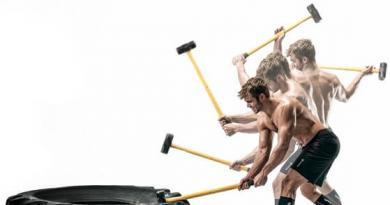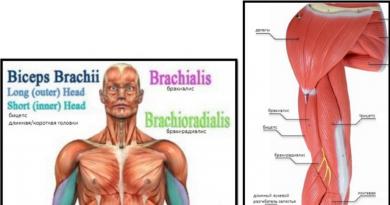Learn about the types of kicking and punching techniques and how to properly train to develop strength and speed when striking.
The content of the article:
In a street fight, it is often enough to deliver one accurate strong blow to emerge victorious from the current situation. Some professional boxers are gifted with this ability from birth, but this does not mean that punching technique cannot be developed at home. That is what we are going to talk about today.
What is percussion technique and how to develop it at home?
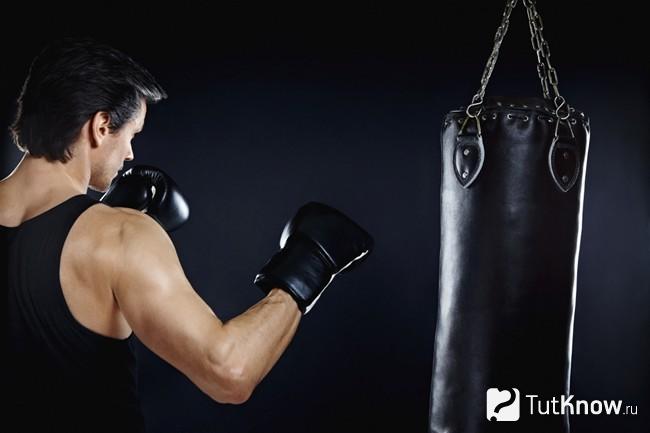
If you want to develop percussion technique at home, then the classes should consist of two stages. Let's get acquainted with each of them in detail.
breakdown

If you have mastered the slip well, you can catch the enemy by surprise, not allowing him to react in time to the blow. At the heart of a qualitative breakdown is relaxation. Simply put, your muscles should be relaxed and your head light. You should not think about what you are going to strike, because an experienced opponent in your actions will be able to predict it. To work out the breakdown, we recommend doing the following exercises:
- Beat on the sound signal- take a fighting stance and relax. Your comrade is located out of sight and at different time intervals gives a sound signal, for example, with a clap. You need to strike at this moment. To complicate the exercise, we recommend using two beeps. One of them allows you to strike, and the second prohibits.
- Hit on touch- similar to the previous exercise, but the partner's touch is used as a signal to attack.
- Paw work- the comrade holds the boxing paw and constantly changes its location. This applies only to the vertical, but also to the horizontal plane.
- Punches to the body of a partner who must bounce- you must have time to get a friend with a blow before he leaves the reach zone.
- Hitting the newspaper- the partner must hold the newspaper sheet by the upper corners, and you strike at it. If you manage to break through the newspaper, then you have made a lot of progress on the path of relapse training.
Overclocking
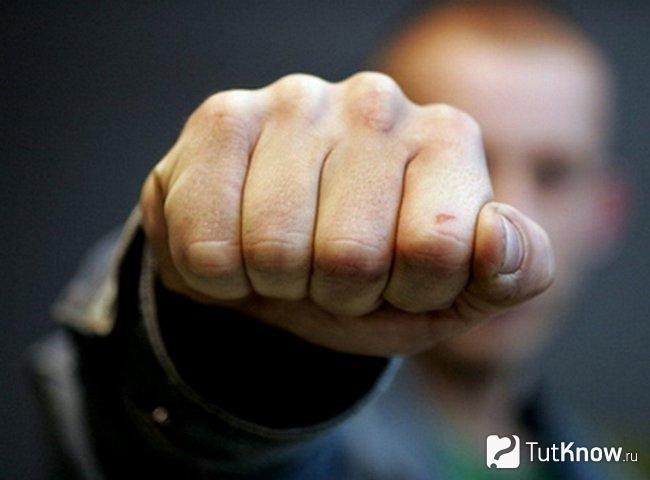
The second stage of mastering percussion techniques at home is called fist acceleration. Here, the speed-strength training of a fighter is of great importance. It is important to develop both components, and not get hung up on one of them. Many athletes believe that vigorous weight training can reduce speed. However, a weak punch can only come in handy in amateur boxing to score points. It won't do any good in a street fight. Here are some exercises to help you increase your punching power:
- Various types of push-ups.
- Bench presses in the prone position - perform the movement without pauses at the extreme points of the trajectories, and the weight should be selected so that 10 to 12 repetitions can be performed.
- Snatch kettlebell with one hand at a fast pace.
- Working with a boxing bag - try not just to hit the surface of the bag, but hit as if you were trying to break through sports equipment.
- Paw work is a great tool for improving your striking technique at home.
How to harden your hands for powerful blows?

Your hands must be prepared to deal hard blows. To do this, we recommend that you use the following training methods.
Push ups
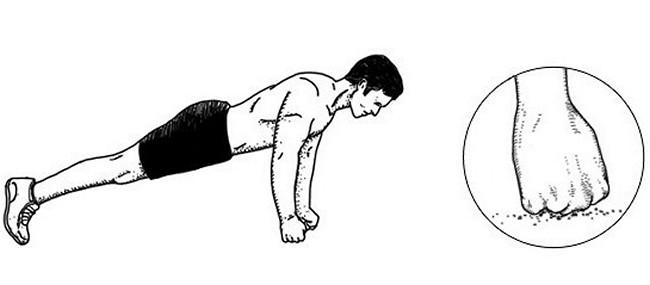
In untrained people, the outer part of the hand is extremely vulnerable to damage. This is due to the absence of large muscles on the phalanges of the fingers that could protect the bone tissue. As a result, after striking, you yourself can fail, breaking your hand. To prevent this from happening, do push-ups on the knuckles and phalanges of the fingers. Start working on a soft surface and gradually move to push-ups from the floor.
Bag handling

Another great way to harden your fists is with a punching bag. Note that most of the bags sold in sporting goods stores are designed to be handled with gloves. The best option would be to independently manufacture this type of sports equipment. You will need to sew a cylinder with a diameter of 50 to 60 centimeters from a double layer of tarpaulin or leatherette.
In the upper part, 2–4 straps are sewn to it for attaching to the ceiling. Insert a bag of sugar or cereal inside and fill it with dry grain. We recommend using wheat or barley. To prevent the grain from moving in the bag, tighten it tightly with a rope. As a result, the bag can serve you for more than ten years. Don't forget. That the cost of such inventory will be much lower in comparison with the store.
Proper striking technique
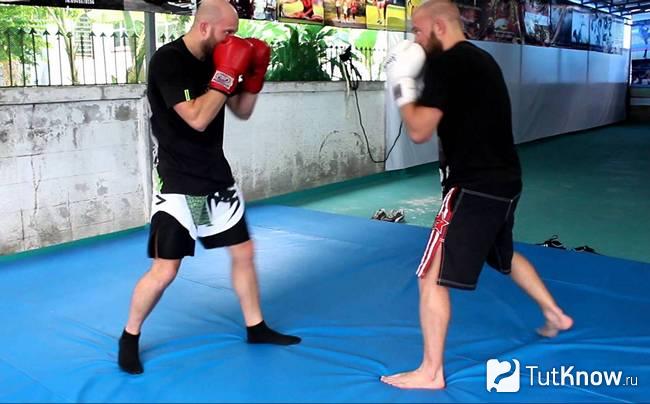
The strength of the impact largely depends on the correct technique, and it is worth starting with its consideration:
- The feet are located slightly wider than the level of the shoulder joints.
- First, the heel comes off the ground.
- During the strike, the foot turns in the direction of the movement of the hand.
- If you strike with your right hand, then the left foot remains in place, and the right foot works.
- The knee joints should be slightly bent, and the weight of the body at the moment of impact is transferred forward.
- The hips must turn towards the opponent at the same time as the attacking arm moves.
- With a close ejection of the arm, a full movement of the body should be made.
- You can not reach forward and sharply turn the body.
- During the swing, you should not take your hand back so as not to show the opponent the moment of striking.
- The fist should be clenched as tightly as possible.
- During the attack, you should exhale.
Striking Technique: Exercises to Develop Speed, Strength and Explosive Energy
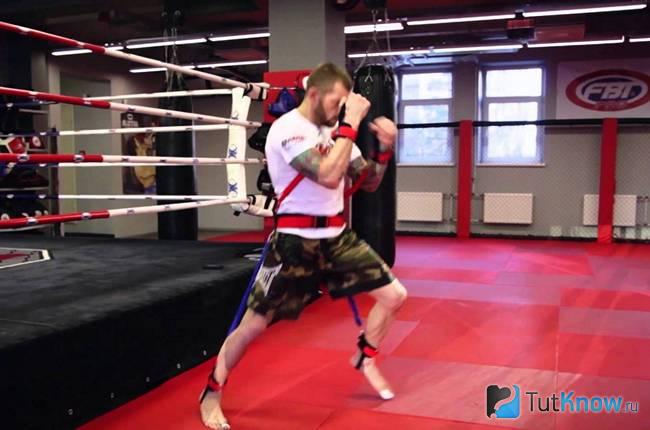
- Kicking the ball. You will need a certain amount of free space to complete the exercise, and if you live in an apartment building, the neighbors downstairs will not be very happy with your workout. We recommend using a special weighted ball used by boxers. In its absence, you can use the basketball. Take a standing position with your feet at shoulder level. Raise the ball over your head and throw it hard to the ground. At least 15 repetitions should be performed.
- Jump squats. The starting position is similar to the previous movement, but you do not need any additional sports equipment. Just do deep squats and jump out of the lowest point of the trajectory of movement. We recommend working until you run out of strength. To complicate the exercise, you can perform it with dumbbells in your hands.
- Pull-ups. Hands on the crossbar are located slightly wider than the level of the shoulder joints. Do the maximum number of times.
- Push ups. The position of the hands is as narrow as possible. It is best to perform the exercise with emphasis on the fists, not the palms.
- Reverse push-ups. You need to sit with your back to a bench or other similar stable surface. Rest your hands on it, and stretch your legs forward. From this starting position, lower yourself down.
- Kettlebell lifts forward. Hold the kettlebell with one hand between your legs. From this starting position, perform a sharp jerk forward, raising your arm to its parallel with the ground. For each arm, perform 8 repetitions.
- Jerk. The exercise resembles the previous one, but the jerk of the sports equipment is performed upwards.
- Jerk with a push. The weight is located between the legs. Take it with your hand, while pushing the pelvis back. With a sharp movement, move the projectile to the shoulder joint, and then push it up. Do 9-10 reps for each arm.
- Kettlebell lifts from a sitting position. Squat down and place the projectile on the shoulder joint. To make it easier to maintain balance, the free hand should be extended in front of you. Start lifting the kettlebell in a vertical plane. When performing the exercise, it is necessary to ensure that the calf muscles and buttocks are in constant tension.
- Kettlebell lifts from a prone position. Take a position lying on your back and raise your hand with the kettlebell up. Begin to rise from this position. The exercise is performed in 10 repetitions.
- Push of two kettlebells. Two sports equipment must be held on the shoulder joints. After inhaling the air, use a jerky movement to lift them up. Movement in the opposite direction should be slow and controlled. Also follow. To keep the abdominal muscles tense throughout the set.
Where should you strike?

No matter how powerful a blow you have, it should be applied to certain places. You must remember that a knockout is the result of a concussion of the cerebellum, after which the nervous system shuts down the body. To knock out an opponent, a blow must be applied to the jaw, temporal region or the back of the head.
Also on the body there are other vulnerable points:
- Liver- in the area of this organ there are reserve blood supplies, and a strong blow can cause spasm, as well as loss of consciousness.
- Solar plexus- a large number of nerve fibers are located here and an accurate blow to them can cause a temporary breathing problem.
- under the heart- if the blow was strong, then it is even possible to stop the work of the organ with a subsequent fatal outcome.
- Groin and lower abdomen- everything is clear and without explanation.
- Mike Tyson can punch with a force of 800 kilos.
- Wladimir Klitschko is somewhat behind, but the strength of 700 kilos is worthy of respect.
- Dmitry Spirichev surpasses even Tyson in this indicator - 850 kilos.
- Michael Zambidis slightly missed the 500 kilo impact force and his score was 498.
- The knee in Thai boxing is the absolute winner, because the impact force can reach 1600 kilos.
- A leg in karate is one of the most modest indicators equal to 450 kilos.
- The fist in boxing has a similar punching force with the leg of a karateka.
- But representatives of taekwondo kick harder than karatekas - 650 kilos.
How to practice percussion technique at home, see below:

